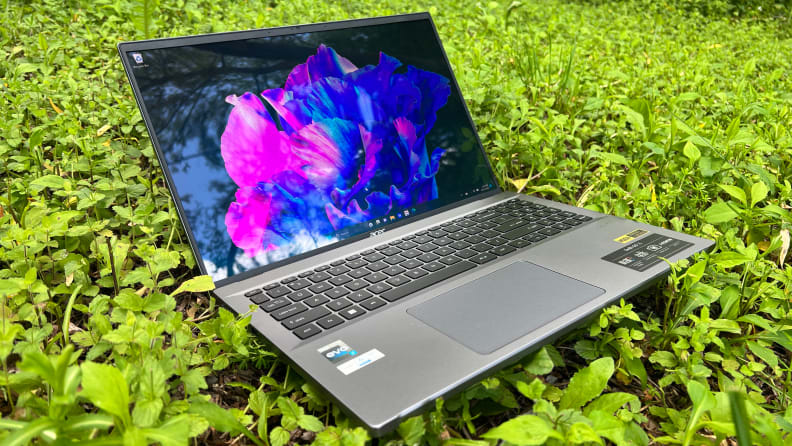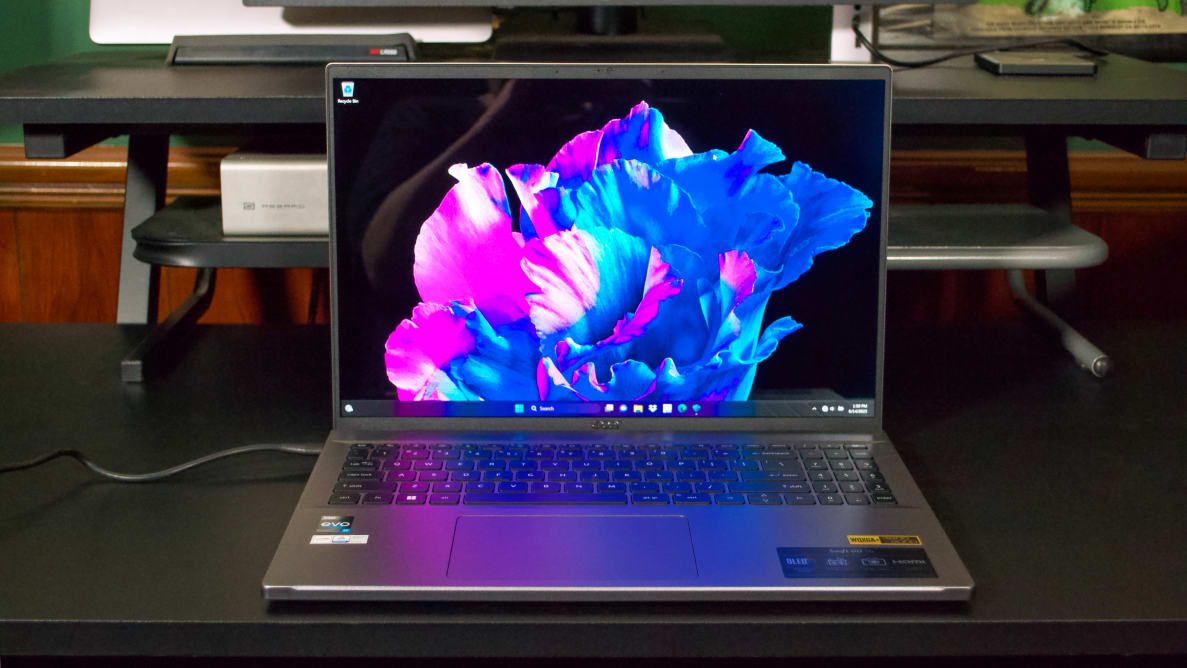Pros
-
Great productivity performance
-
Solid, yet lightweight chassis
-
Great touchpad, decent keyboard
Cons
-
OLED screen doesn’t get very bright
-
Can run warm
About the Acer Swift Go 16
Here are the specs of the laptop we tested:
- Price as configured: $1,200
- Processor: Intel Core i7-13700H
- Graphics: Iris Xe Graphics (96 EUs)
- RAM: 16GB LPDDR5 6400MHz
- Storage: 1TB PCIe NVMe SSD
- Display: 16-inch, 3200 × 2000, 120Hz, OLED
- Wireless connectivity: Wireless Wi-Fi 6E, Bluetooth 5.1
- Camera: 1440p, 60FPS
- Wired connectivity: 2x Thunderbolt 4, 2x USB-C 3.2 Gen 1, 1x HDMI, 1x 3.5 mm headphone jack, 1x microSD
- Battery: 3-cell, 65Wh
- Weight: 3.64 pounds
- Size: 14.0 × 9.6 × 0.59 inches
- Warranty: 1-year limited warranty
The Acer Swift Go 16 is available in two configurations. We’re looking at the higher-end version for this review. The lower-spec model has a 1920 x 1200 LED display, Intel Core i5-1335U CPU, 8GB RAM, and 512GB storage. Retailing for $800, this model is considerably more affordable.
What we like
Solid, lightweight build

The Acer Swift Go 16 has a sleek and elegant design that feels reminiscent of a MacBook Pro.
The first thing you’ll notice about the Acer Swift Go 16 is its appearance. This is a sleek, elegant design, thanks in part to the all-aluminum construction. The sharp edges and rounded corners make it look like a Windows-powered take on a MacBook Pro, but the recessed keyboard and different hinge design give the Swift Go 16 a look of its own.
The aluminum build also means that this laptop feels quite solid. As with any laptop, you don’t want to drop it, but it feels like this is a laptop that will remain sturdy for years. This includes the hinges, which are somewhat on the stiff side. You can open the laptop one-handed, but not without a little extra effort.
The Swift Go 16 is relatively light, weighing in at just over three and a half pounds, or just a touch more than the M2 MacBook Pro 16. Compared to older aluminum laptops, that’s light enough that you could almost start to doubt that it’s actually made from aluminum.
There are plenty of connectivity options, too. On the left side of the Swift Go 16, you’ll find a pair of Thunderbolt 4 ports that double as power ports. On this side, you’ll also find the full-size HDMI port and a USB 3.2 Gen 1 port. The right side includes a second USB 3.2 Gen 1 port, a 3.5mm headphone jack, a microSD slot, and a Kensington lock slot.
Powerful productivity performance
Acer picked a good processor for its Swift Go 16. Intel’s 14 (Tetradeca) Core i7-13700H is used in many productivity-oriented laptops and for good reason. It’s speedy, especially in combination with 16GB LPDDR5 memory.
When it came to Geekbench 6, the Swift Go 16’s single core and multicore scores put it in the top five productivity laptops we’ve tested to date—even higher than the M2 Pro-powered 2022 Apple MacBook Pro 14 in certain tests. This wasn’t a fluke either, as the Swift Go 16 scored the highest we’ve seen in our other CPU benchmark, Cinebench R23, in this category to date. Its multicore performance wasn’t as impressive, according to Cinebench, but at least for now, the Swift Go 16 is still in our top 10.
The Swift Go 16 performed well in our Microsoft Excel test, too, completing the benchmark in just 37 seconds. This is not the fastest time we’ve seen, with some laptops taking under 30 seconds, but it’s still quite a bit faster than many other laptops at this price point that we’ve used to run the same test, like Acer’s own Swift 3 OLED and the newest LG Gram 17.

The Cinebench R23 Single Core benchmark measures how fast a CPU can process instructions on only a single core (i.e. games and other lightly threaded applications). It stresses the CPU longer than Geekbench 6 and runs a 3D rendering test.
With Intel’s Iris Xe integrated chip as the only graphics option, the Swift Go 16 definitely isn’t a gaming PC. That said, while you won’t be doing much gaming at the laptop’s native 2000p resolution, the 3DMark Night Raid benchmark estimates that you’ll easily get framerates above 150 frames per second (fps) in Fortnite in Ultra mode at 1080p and nearly the same in GTA V.
This means the integrated graphics are powerful enough for light gaming and occasional video editing, but if you play graphically intense games, you’ll need to lower the settings.
One of the biggest advantages of opting for the higher-spec version of the Acer Swift Go 16 is the OLED display. Whether you’re taking your work outside with you on a beautiful day, or you just need to take a break and spend a few minutes watching videos or editing some vacation photos, the screen is a joy to look at, no matter where you take it.
Its brightness peaked at 394 nits in our testing, and while this isn’t as bright as the 457-nit display on the Dell XPS 17 the OLED display makes for deeper blacks and improved contrast. This adds a level of perceived brightness that makes the screen seem brighter than it really is.
I tested the laptop outside on a sunny day, and while there were reflections on the glossy screen, it was still bright enough that I had no issues seeing what was on the screen in front of me.
Smooth touchpad, decent keyboard

The Acer Swift Go 16's port connectivity options make it a versatile work or personal machine for just about any situation.
The touchpad is another high point of the Swift Go 16. It has a large area at just under five inches wide and three inches tall, and it’s made with what Acer calls OceanGlass, which uses offshore recycled plastics and makes up all the trackpads in Acer’s Swift and Chromebook laptops. It doesn’t feel exactly like glass, but it’s still smooth and a joy to use.
While the touchpad isn’t perfect if you’re a press-down-to-click type of person, as it requires just a bit too much force to press down, it does an impressive job at palm rejection. Tap-to-click also works very well, and I never encountered any missed clicks or accidental clicks when I was trying to move the mouse cursor.
The keyboard isn’t as instantly enjoyable as the touchpad, but that’s mostly par for the course across this laptop category at this price. The keys don’t feel as nice as a MacBook Pro, as they’re slightly mushy and the key travel is longer than the Mac, but they’re still fine.
You get a full numpad, which is great if you frequently use one for data entry to accounting, but the left-offset keyboard can take some getting used to if you’re coming from a laptop with a centered keyboard, like the Apple MacBook Air M2.
Acer integrated the touch sensor into the power button, which is a nice touch as it keeps it from taking up space anywhere else on the keyboard.
What we don’t like
It gets warm

Acer's Swift Go 16 is another of its laptops that uses OceanGlass for the trackpad, or offshore recycled plastics.
Almost immediately after I started testing the Swift Go 16 I noticed the fans spun up fairly often, even as the laptop was idling. This seemed aggressive, considering the laptop wasn’t doing much, and this was in the Balanced power mode before I switched it to Performance mode for our benchmarks.
Unfortunately, that is what happened to the Swift Go 16, but to a worse degree than many competing Intel-based laptops we’ve tested.
In our chassis temperature test, it reached 40 degrees Celsius (104.3 Fahrenheit) on the underside of the laptop. This isn’t going to burn you, but this laptop can certainly become uncomfortably warm if it heats up while it’s on your lap.
Things heat up even more when it comes to the CPU. In our maximum CPU temperature test, the Core i7-13700H hit a high of 93 C (199.4 F). That’s not especially unusual for CPU temperatures, but in this case, our test reported that this caused thermal throttling, or what happens when CPU performance is reduced to keep the CPU from getting even hotter.
Performance is still speedy, but if you plan on using this for video or other more CPU-intensive tasks, this could end up being a major frustration.
Average battery life
The 3-cell, 65-watt-hour battery in the Acer Swift Go 16 is fairly standard when it comes to capacity for laptops in this class and price range. That said, the battery life is decidedly average. It’s not terrible, but don’t expect anything too special.
In our test, the battery lasted 7 hours and 25 minutes. That puts it into the bottom third out of all of our battery tests in this category, alongside Dell’s XPS 13 Plus and HP’s 2-in-1 Spectre x360 14, which also had battery life that didn’t thrill us.

To test battery life, we set the laptop display as close to 200 nits as possible, set the power saver to 10%, and set the screen to never turn off. We run a Chrome plug-in that automatically cycles through 20 tabs until the battery fully depletes.
However, the Swift Go 16 managed over 7 hours only after I switched to the 2.4GHz Wi-Fi band. The 5.0GHz band drained the battery faster, topping out at about 4 hours instead. (We’ve never encountered this before, and it’s left us scratching our heads.)
Granted, our battery test is quite aggressive. If you’re using this for a typical workday, you’ll easily get through the day without needing a charge, unless you’re using the Swift Go 16 for CPU-intensive tasks.
Should you buy the Acer Swift Go 16?
Maybe, it has plenty of performance, but a few tradeoffs

The Acer Swift Go 16 has the same excellent performance as more expensive laptops, but its battery life could be a deal breaker for some.
There’s a lot to like about the Acer Swift Go 16’s performance. It scored high in some of our benchmarks and held its own against more expensive laptops, like the Lenovo Yoga 9i Gen 8 and LG Gram 17, even the MacBook Air M2. It’s no gaming laptop, either, but it will easily manage all the browser tabs you throw at it, and make major productivity apps like Excel fly.
Its design is elegant as well, even if it does borrow a lot from the MacBook Pro school of design. The build feels as solid as a MacBook, while the weight would almost fool you into thinking the laptop is built out of plastic. (Just the trackpad.)
But the Acer Swift Go 16 gets warm. Not enough to burn you or make your skin uncomfortable, but the fans do spin up quite often, even when you’re not pushing the laptop. This, combined with the just okay battery life, means the Acer Swift Go 16 doesn’t stand out against similarly priced laptops that have longer battery lives and better temperatures.
On the other hand, if you’re looking for a productivity laptop that will mainly stay parked on your desk, you could certainly do a lot worse.
Meet the tester

Kris Wouk
Contributor
Kris Wouk is a freelance tech writer and musician. While he's been writing about technology for more than 10 years, that's a drop in the bucket compared to the amount of time he has spent enamored with tech. When he's not testing gadgets, he spends most of his time in Ableton Live.
Checking our work.
Our team is here to help you buy the best stuff and love what you own. Our writers, editors, and experts obsess over the products we cover to make sure you're confident and satisfied. Have a different opinion about something we recommend? Email us and we'll compare notes.
Shoot us an email



